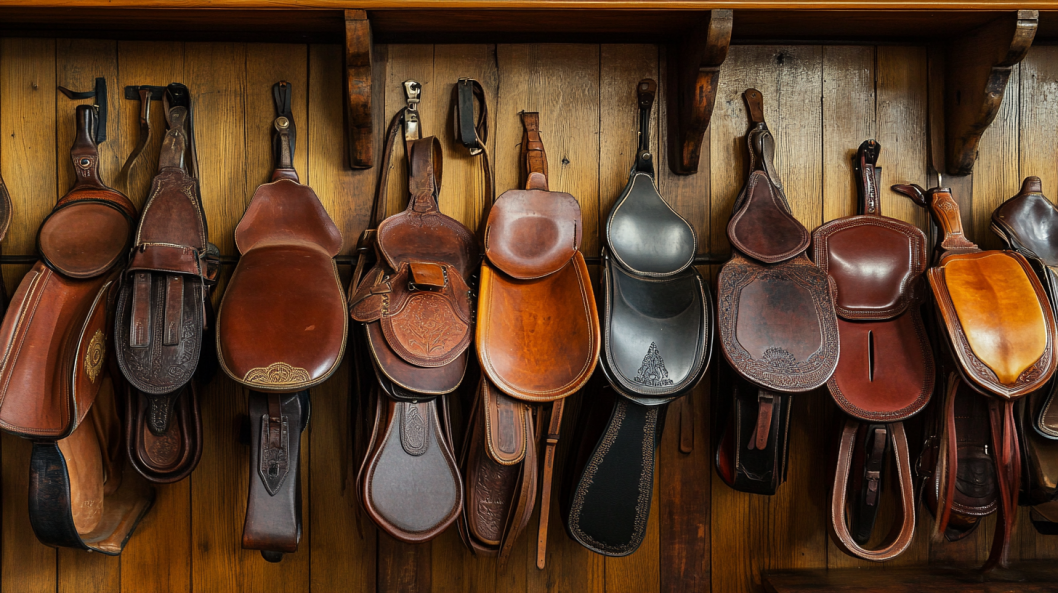Choosing the right saddle is crucial for both the rider’s comfort and the horse’s well-being. Horse saddles come in various styles, each designed to meet different needs and preferences. Therefore, selecting a saddle that complements the horse’s conformation and the rider’s needs is crucial for a harmonious and effective riding experience.
In my opinion, choosing the right saddle can be a game-changer in your riding experience. The saddle you select affects your comfort and significantly impacts your horse’s performance and well-being. A well-chosen saddle can enhance communication between rider and horse, while a poor fit can lead to discomfort or even injury. In this blog post, we’ll explore the most common types of horse saddles and their specific uses.
1. English Saddles
- All-Purpose Saddle The all-purpose saddle is a versatile choice suitable for various disciplines, from jumping to dressage. It provides a balanced seat and moderate knee rolls, making it a good option for riders who want a single saddle for multiple activities.
- B. Dressage Saddle Dressage saddles are designed specifically for dressage riding, focusing on precision and communication with the horse. They feature a deep seat, high cantle, and long flaps to support a close contact position and promote proper alignment.
- C. Jumping Saddle Jumping saddles are built to offer stability and security during jumps. Compared to dressage saddles, they have a more forward-cut flap and less padding in the seat, allowing for a better range of motion and a more secure position over fences.
2. Western Saddles
- A. Roping Saddle Roping saddles are designed for cowboys and cowgirls who need a sturdy saddle for roping cattle. They feature a thick, padded seat, a horn for securing the rope, and heavy-duty rigging to handle the stress of roping.
- B. Barrel Racing Saddle Barrel racing saddles are tailored for speed and agility around barrels. They have a lightweight design, a low cantle, and a forward-tilted seat to help the rider stay balanced and maneuver quickly.
- C. Trail Saddle Trail saddles are made for long rides and comfort. They usually have a cushioned seat, plenty of storage options like saddlebags, and a design that distributes weight evenly to ensure a comfortable ride for both horse and rider.
3. Endurance Saddles
Endurance saddles are built for long-distance riding. They prioritize comfort and weight distribution, often featuring a lightweight design, ergonomic seat, and adjustable components to accommodate both horse and rider over extended periods.
4. Australian Saddles
Australian saddles, also known as stock saddles, are a hybrid between Western and English saddles. They offer a deep seat, high cantle, and a unique design that combines the stability of Western saddles with the comfort of English saddles, making them suitable for various riding activities.
5. Treeless Saddles
Treeless saddles lack a traditional tree, which can offer greater flexibility and comfort. They conform closely to the horse’s back and can be adjusted to fit different horses, but they may not provide as much support for the rider as traditional saddles.
6. Side Saddle
Side saddles are designed for riding with both legs on one side of the horse. This style is often associated with traditional and formal riding disciplines. They have a unique design with a high pommel and a deep seat to ensure stability and safety for the rider.
Choosing the Right Saddle
Selecting the right saddle depends on various factors, including the rider’s discipline, the horse’s conformation, and personal preferences. It’s essential to consider how the saddle fits the horse and rider to ensure comfort and performance. Consulting with a saddle fitter or an experienced rider can help you find the best option when in doubt.
In my view, a well-fitting saddle greatly enhances your riding pleasure and plays a crucial role in your horse’s comfort and performance. However, an ill-fitting saddle can lead to problems that range from slight discomfort to severe health issues for the horse. Investing time and effort into trying out various saddles and seeking professional advice to achieve the optimal fit for you and your horse is important.





